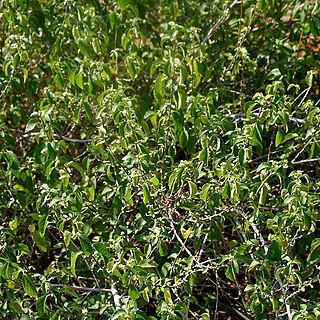A much-branched often aromatic (vars. fruticosa, villosa, leaves smelling of hops when crushed) shrub or small tree up to 4 m. tall.. Stems sparingly to densely puberu-lous or pubescent or tomentose at first, later ± glabrescent, greenish at first, later becoming reddish-, greyish-or purplish-brown.. Petioles 0.2–4.5(–7) cm. long, hairy ± as the stems; leaf-blade ovate, elliptic-ovate, triangular-ovate or ovate-rhomboid, (1–)3–7(–9) cm. long, (0.7)–1–4.5(–5.5) cm. wide, obtuse or obtusely, sometimes sub-acutely, gradually acuminate, mucronulate, cuneate or rounded, rarely shallowly cordate (var. eglandulosa), coarsely crenate or crenate-serrate, membranous to thinly chartaceous, (3–)5(–7)-nerved from the base, lateral nerves 4–5 pairs, the undersurface sparingly or evenly beset with small pellucid yellow glands (except var. eglandulosa), subglabrous or sparingly pubescent or pilose above and beneath, and more so on the midrib and main veins, bright yellow-green or dark green.. Stipules triangular-lanceolate to subulate-lanceolate, 2–5 mm. long, keeled, ciliate or not, evenly pubescent, or sometimes pubescent only on the keels.. Inflorescences ± spicate, axillary, solitary, up to 5.5 cm. long, sometimes unisexual, but usually androgynous, with a sessile, subsessile or shortly pedunculate terminal male portion, densely congested at first but later ± interrupted, and 1–7 bracteate female flowers at or near the base; allomorphic flowers 0; axis evenly puberulous to densely tomentose; outer male bracts broadly ovate, somewhat cupular, 1 mm. long, densely pubescent; inner male bracts linear-subulate, 0.5 mm. long, gland-tipped (except var. eglandulosa), pubescent; female bracts somewhat leaf-like, strongly accrescent, broadly ovate or reniform, cupular, 0.2–1.2 cm. long, 0.3–1.7 cm. wide, rounded at the apex, rounded or shallowly cordate at the base, dentate or crenate-dentate, yellow gland-dotted beneath (except var. eglandulosa), often fairly prominently ribbed beneath, glabrous or subglabrous above, glabrous or sparingly or evenly pubescent beneath, especially on the ribs, 1-flowered.. Male flowers subsessile or shortly pedicellate; buds tetragonous-subglobose, densely pubescent.. Female flowers sessile; sepals 3, ovate-lanceolate, 1 mm. long, ciliate; ovary subglobose-trilobate, 0.7 mm. diameter, ± smooth, with numerous yellow glands in the grooves between the lobes (except var. eglandulosa), densely pubescent or pilose; styles ± free to the base, 4 mm. long, laciniate, pink or red.. Fruits trilobate, 2 mm. long, 3 mm. diameter, yellow gland-dotted (except var. eglandulosa), evenly pubescent or pilose.. Seeds ellipsoid-ovoid, 1.5–2 mm. long, 1–1.3 mm. wide, smooth, brown, with an elliptic vulviform caruncle.
More
An erect shrub. It grows 3.5 m high. It can be hairy. The leaves can give a bad smell when crushed. The leaves are simple and oval. They are arranged alternately. The leaves are 1-8 cm long. There are round teeth along the edge. The leaves are grey-green underneath. The flowers are separately male and female. They are small and yellow to red. They hang in spikes. Usually the male flowers are above and the female ones below but they can be on separate plants. The fruit is a very small capsule 2-3 mm across.


